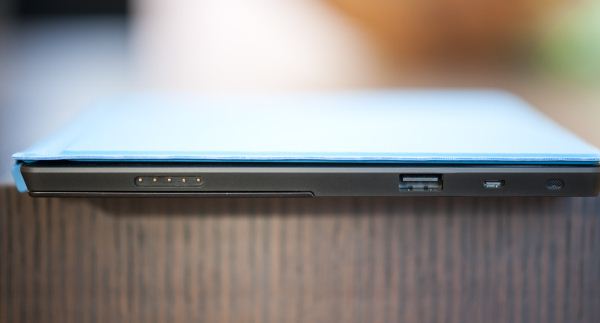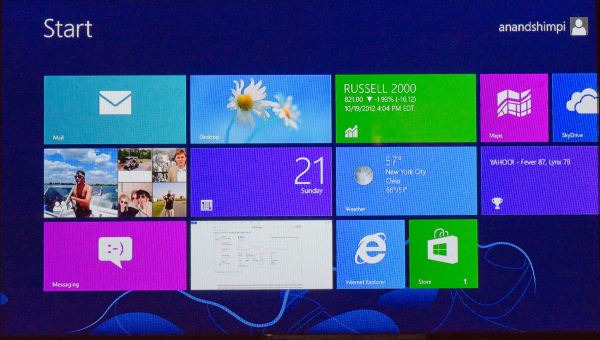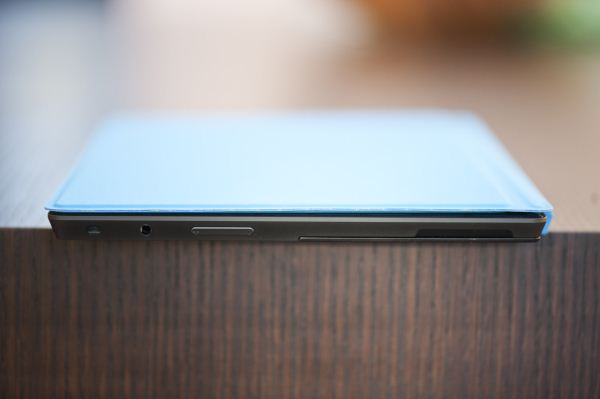Microsoft Surface Review
by Anand Lal Shimpi on October 23, 2012 9:01 PM EST- Posted in
- Tablets
- Microsoft
- Mobile
- Surface
- Windows RT
A Plethora of Ports and Storage Options
One area where Surface is a significant departure from the iPad is in its IO and expansion. The iPad features a single dock (and soon to be Lightning) connector, while Surface looks more like a laptop (or Android tablet) when it comes to IO.
There’s no port for syncing, you get content onto Surface via WiFi or a more traditional method. Surface has a single USB 2.0 port on the right side of the device. You can plug almost anything you want into this port, including USB storage devices of course. Behind the kickstand is a single microSD card slot, giving you another option for expansion.
On the left edge of the device there’s a micro-HDMI out port that can be paired with a Microsoft made VGA or HDMI dongle (both dongles have a 22-degree connector on them to mate flush with Surface). I tested HDMI output with Microsoft's dongle and unfortunately the result wasn't very good. The 1080p output had a lot of issues with scaling quality (as you can see from the shot below) and there was a lot of tearing on the screen with a big impact on UI frame rate. I reached out to Microsoft for an explanation but have yet to hear anything.
Finally there’s a standard 1/8” headphone jack along the top of the device.
Power delivery comes via a custom magnetic connector along the lower right side of Surface.
Given that the internal storage is an eMMC solution, performance from the microSD slot with a good card should be fairly comparable. In practice I could read and write a large sequential file at roughly 10.5 MB/s using a SanDisk microSD card.
Copying from a fast USB stick to Surface’s internal storage gave me transfer rates closer to 17MB/s. There are a few vendors for Windows 8/RT eMMC devices, I’ll be paying close attention over the coming weeks to figure out who makes the best. I know Microsoft and Intel (among others) have been playing close attention to the eMMC providers with hopes of weeding out those that deliver honestly unacceptable performance.
While doing background file IO I didn’t notice any of the stalling/pausing that we’ve seen on some of the more recent Android tablets.
Update: Many have asked about how much storage is taken up by the Windows + Office 2013 installs. The screenshot below shows the directory size for both C:\Windows and C:\Program Files, the latter is where the Office15 install files are included (and yes winword.exe is still the Word executable).
You're looking at roughly 6.47GB for Windows RT and then another 830MB for Office for a grand total of around 7.3GB.
USB Compatibility
Microsoft is particularly proud of its single USB 2.0 port on Surface. Although USB ports have been featured on several Android tablets, their support was typically limited to flash drives, keyboards and mice. With Windows RT, Microsoft wants to bring more of the traditional Windows experience to tablets. Had Surface been x86 based, you would be able to plug in virtually any USB peripheral and it would just work. As the first version of Surface is based on an ARM SoC, driver support is a little more limited but still pretty decent.
USB drives obviously work as you’d expect them to. Even SATA to USB adapters worked fine when plugged into Surface. Other smartphones and tablets also worked, although their level of support varied. For example, you can plug in the iPhone 5 and have it come up as a supported device for moving pictures to/from. However USB tethering is not supported by the class driver included in Windows RT. You can even plug an iPad into Surface and get the same level of support.
Printer support is pretty decent, although the Epson Workforce 910 I tried didn’t actually have specific driver support under RT. Although development for the desktop side of Windows is limited, manufacturers can supply Windows RT drivers to enable support for some more obscure devices. Unfortunately when it comes to those devices you’ll have to play the waiting game as there’s simply not a lot of third party Windows RT drivers available for download today.






_575px.png)








235 Comments
View All Comments
Netscorer - Wednesday, October 24, 2012 - link
For a corporate customer RT will never be a solution. And that touch keyboard is non-usable, period. Anand was going round and round about how you must strike with fore and precision to make it count, how you must go through the prolonged learning curve, how you don't have any tactile response. Just trying not to sound too negative on the keyboard. The only positive he said about keyboard (if you remove all the colored words) is that at the end of he day it is better then typing on glass. Big deal. Anything is better then typing on glass.As for the Surface being a hybrid between laptop and tablet and how this is a perfect match, let me agree to disagree with you. In concept, taken abstract device that can work for me in my 9 to 5 life and 6 to 10 life, yes it would be great. This particular implementation of Windows 8 RT with strained hardware and lousy screen (in part because higher res screen would strain that hardware even more) - the answer is no.
xype - Wednesday, October 24, 2012 - link
Yeah, it felt a bit that way, didn’t it? But then, AnandTech reviews often feel like they’re written by someone who’s just excited about their newest toy and go a lot into hardware, too. While for other kinds of hardware that isn’t as big of a deal, reviewing smartphones and tablets should go into a different direction, I think.That tablet manufacturers can put in decent hardware and that a company like Microsoft is actually competent enough to produce a well designed tablet should be a given by now.
But a tablet or smartphone are not something you stuff into your PC tower and forget about it, like a graphics card or CPU fan. Is it comfortable to use on the lap, is the lack of USB charging annoying in day to day use, is Excel really usable for something like bookkeeping without being annoying after 5 minutes, does it work well as an ebook reading device, etc?
To be fair, ArsTechnica’s review is a bit better but still doesn’t go into software _at all_. That’s not confidence inspiring to me…
phexac - Wednesday, October 24, 2012 - link
Agreed. Just look at iPad reviews. They ALL state "it's a pleasure to use" and then go into zillion reasons for why. This review spent more time raving about a kickstand (btw how do you kickstand it in your lap? so this is desktop only portable device???) than about the experience of actually using Surface. Could always be because using it is actually pretty meh and nothing to write about.phexac - Wednesday, October 24, 2012 - link
Definitely agree with this. Anand's negative points seemed to be pretty close to deal breakers, and yet they were completely skimmed over. As was the fact that apps take 2.5-5 times longer to start than on a tablet. And a complete omission of actually using software on the tablet. Just looking at the pictures with typical desktop tiny menus in the programs and desktop interface makes you wonder how practical it is to it is as a touch device wen anything bigger than a mouse pointer would be too big for those menus.seapeople - Saturday, October 27, 2012 - link
So what is it then? Is Anand an Apple fanboi because he made the Surface seem boring, or is he a Windows schill because he glossed over the down falls of Surface?It's got to be one or the other, right? It's not possible that this review is actually accurate to the product?
WP7Mango - Wednesday, October 24, 2012 - link
Why should you care who Microsoft are targeting with this device? Think about it for a second...If you don't know who it's for, then it's clearly not for you. But it might fit someone else's requirements perfectly, and if it does then that is of no consequence to you - so don't worry about it.
B3an - Wednesday, October 24, 2012 - link
I had a good feeling about this tablet, and it was right. Surface RT is clearly an excellent tablet.But i would have prefered one with Intel Clover Trail. As mentioned, we need to see battery life with this SoC, but i very much expect it to be close to the ARM based Surface.
Surface would be perfect with Clover Trail. Same form factor, fanless, better performance than ARM, and the full blown Win 8. And yes i know theres the Pro version of Surface in 3 months time, but the Core i5 is overkill for many, it needs a fan too, and obviously will have much lower battery life. Clover Trail would have been the perfect balance for most people.
Such a shame, so close to my perfect idea of a tablet, but i'd happily still have ARM + Surface RT over a iPad or Android tablet for so many reasons.
Netscorer - Wednesday, October 24, 2012 - link
Completely agree with you. Good and usable Atom-based Intel CPU, which is x86 compatible, married with Windows 8 and all that effort that Microsoft clearly made to make you feel like you own a premium product with Surface - this would have been wonderful. This is what Microsoft should have released at the beginning, leaving Windows 8 RT to the sub $300 bargain tablets from 3-rd party vendors.Clearly, Intel could not commit to the Oct.26 release date and it forced Microsoft's hand at developing this half-baked solution. We also don't know how good Clover Trail Atom will be. Because if it's really going to be good, this will be the first actually usable Intel Atom processor. Especially if they will marry it with HD4000 GPU.
karasaj - Wednesday, October 24, 2012 - link
Honestly, if Surface had launched with Tegra 4 (not possible sadly) or S4 Pro (should have been possible) or even S4 Krait, it would be insanely nice. Performance is only barely "below" what it really needs to be to be unnoticeable - a tablet/notebook that runs office, netflix, and the occasional game (and internet browsing). An ARM cpu with better IPC would have been a better choice over 4 cores, imo.I wish Surface would re-release with the S4 Pro or something. I would completely buy that. Atm, I'm deciding whether or not it's worth it. I certainly like the idea of it, it just seems like it -might- be a tad under powered.
beginner99 - Wednesday, October 24, 2012 - link
$699. Thats more I paid for my already overpriced Asus T91 netbook (has touchscreen and can be used in tablet form) over 3 years ago. While Surface sure has better battery life and Win RT is better suited for touch device, I don't see a reason to replace it with surface. but then I hardly ever use it anyway.$699 is the price I would pay for the version with real windows and more capable CPU. Wasn't following the rumors so don't know if that actually will be made at all?